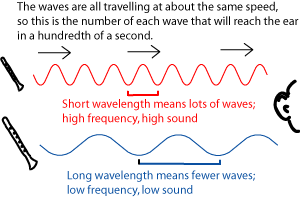| << Chapter < Page | Chapter >> Page > |
Any sound that you hear as a tone is made of regular, evenly spaced waves of air molecules. The most noticeable difference between various tonal sounds is that some sound higher or lower than others. These differences in the pitch of the sound are caused by different spacing in the waves; the closer together the waves are, the higher the tone sounds. The spacing of the waves - the distance from the high point of one wave to the next one - is the wavelength .
All sound waves are travelling at about the same speed - the speed of sound. So waves with a longer wavelength don't arrive (at your ear, for example) as often (frequently) as the shorter waves. This aspect of a sound - how often a wave peak goes by, is called frequency by scientists and engineers. They measure it in hertz , which is how many wave peaks go by in one second. People can hear sounds that range from about 20 to about 17,000 hertz.
The word that musicians use for frequency is pitch . The shorter the wavelength, the higher the frequency, and the higher the pitch , of the sound. In other words, short waves sound high; long waves sound low. Instead of measuring frequencies, musicians name the pitches that they use most often. They might call a note "middle C" or "2 line G" or "the F sharp in the bass clef". (See Octaves and Diatonic Music and Tuning Systems for more on naming specific frequencies.) These notes do have definite frequencies (Have you heard of the "A 440" that is used as a tuning note?), but musicians usually find it easier just to use the note names.


Notification Switch
Would you like to follow the 'Sound, physics and music' conversation and receive update notifications?